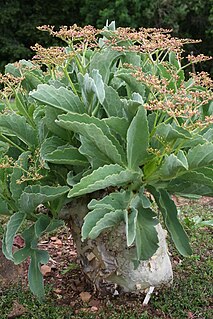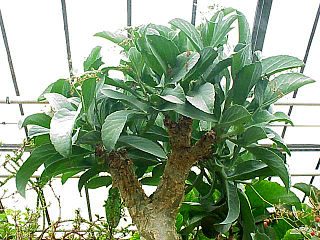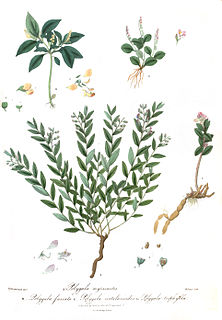
The Vitaceae are a family of flowering plants, with 14 genera and around 910 known species, including common plants such as grapevines and Virginia creeper. The family name is derived from the genus Vitis.

A vine is any plant with a growth habit of trailing or scandent stems, lianas or runners. The word vine can also refer to such stems or runners themselves, for instance, when used in wicker work.

Friedrich Martin Josef Welwitsch was an Austrian explorer and botanist who in Angola discovered the plant Welwitschia mirabilis. His report received wide attention among the botanists and general public, comparable only to the discovery of two other plants in the 19th century, namely Victoria amazonica and Rafflesia arnoldii.

Cissus is a genus of approximately 350 species of lianas in the grape family (Vitaceae). They have a cosmopolitan distribution, though the majority are to be found in the tropics.

Cyphostemma is a flowering plant genus in the family Vitaceae, with around 250 species distributed throughout the tropics and subtropics. These species are caudiciform and used to belong to the genus Cissus. The genus name comes from Greek kyphos, meaning hump, and stemma, meaning garland.

Cyphostemma juttae is a slow-growing succulent species of Cyphostemma from southern Africa, well known as an ornamental plant.

Tetrastigma is a genus of plants in the grape family, Vitaceae. The plants are lianas that climb with tendrils and have palmately compound leaves. Plants are dioecious, with separate male and female plants; female flowers are characterized by their four-lobed stigmas. The species are found in subtropical and tropical regions of Asia, Malaysia, and Australia, where they grow in primary rainforest, gallery forest and monsoon forest and moister woodland. Species of this genus are notable as being the sole hosts of parasitic plants in the family Rafflesiaceae, one of which, Rafflesia arnoldii, produces the largest single flower in the world. Tetrastigma is the donor species for horizontal gene transfer to Sapria and Rafflesia due to multiple gene theft events.

The genus Cayratia comprises approximately 45 species of plants, some of which have utility value to people. It is found in tropical and subtropical areas of Asia, Africa, Australia, and islands of the Pacific Ocean.

Pachycauls are plants with a disproportionately thick trunk for their height, and few branches. The word is derived from the Greek pachy- meaning thick or stout, and Latin caulis meaning the stem.

Cyphostemma currorii is a succulent tree belonging to the family Vitaceae and reaching a height of 6 meters or more. This plant is also known as cobas tree and butter tree. Cyphostemma currorii is found in hot, arid rocky places, and has been seen from southern Angola to Namibia and is common on the Brandberg.

Cyphostemma cirrhosum is a species of plant native to southern Africa. It is a soft-stemmed creeper with succulent, yellowish-green leaves. It bears yellow flowers and red, oval-shaped fruit.

Argyrolobium is a genus of flowering plants in the legume family, Fabaceae. It belongs to the subfamily Faboideae. Members of this genus are found in Africa and south Asia.
The molecular formula C28H22O6 (molar mass: 454.47 g/mol, exact mass: 454.141638 u) may refer to :

Cyphostemmin A is an oligostilbene found in Cyphostemma crotalarioides (Vitaceae). It is a resveratrol dimer.

Cyphostemmin B is an oligostilbene found in Cyphostemma crotalarioides (Vitaceae). It is a resveratrol dimer.

Cyphostemma mappia is a species of caudiciform succulent plant endemic to Mauritius. It is sometimes known as the "Mauritian baobab", though it is member of the grape family (Vitaceae) and unrelated to the true Baobabs of Africa.
Cyphostemma ternatum is a perennial climbing herb that grows up to 2m. It is edible and distributed throughout Northeast Africa to southern Arabia. ternatum in Latin means "arranged in threes" and alludes to the arrangement of the leaves.
Halas is a Yemeni food that is made of Ḥalaṣ leaf. The food is eaten during drought periods in Yemen.

Polygala crotalarioides is a species of flowering plant in the family Polygalaceae. It is endemic to Southeast Asia.















